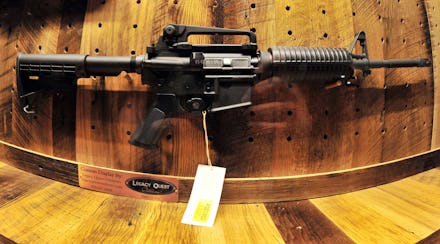A Brief History of the AR-15, the Weapon Behind the Deadliest Shootings in the US

Early Sunday morning, a gunman opened fire in a gay nightclub in Orlando, Florida, killing at least 49 people and injuring 53 others. The suspected shooter, 29-year-old Omar Mateen of Port St. Lucie, Florida, used the same style of weapon as Adam Lanza did at Sandy Hook Elementary School in 2012; as Syed Rizwan Farook did at the Inland Regional Center in San Bernardino, California, in December; as Chris Harper Mercer did at Umpqua Community College in Roseburg, Oregon, in October: an AR-15.
According to the National Rifle Association, AR-15s are "America's most popular rifles."
Widely available, lightweight and customizable, the AR-15 is a semi-automatic firearm often and incorrectly termed an assault rifle. It's also been the weapon of choice for the most staggering mass shootings in recent memory.
This has almost everything to do with two facts: The AR-15 is entirely legal to own and, for those with $900 to $1,800 to toss around, not particularly difficult to procure — there are an estimated 3 million AR-15s in the United States.
The AR-15 is billed as a hunting rifle, a representation that stretches the limits of credulity because the gun is essentially a civilian's M16. It's "marketed more toward civilians who want to play war," says ThinkProgress, than toward those looking to bag a deer.
But there's a novelty aspect to the weapon that's drawing people to it. According to Breitbart, it's the impressive array of accessories available for fixes and improvements that has transformed the AR-15 into "the Colt 1911 of rifles."
"You can always buy the part you need to make it better or repair it in the event that something breaks," Breitbart's Awr Hawkins writes. It's also "great for women as well as men," for people of all different frames, which perhaps helps explain why the San Bernardino shooters, one of whom was a woman, chose it.
"You can take the whole gun apart and replace any part you want to without special tools, without knowing a whole lot," says Tim McDermott, a range officer at the Personal Defense and Handgun Safety Center in Raleigh, N.C. told the New York Times. "They are Legos for guys."
But, as retired Marine infantryman Thomas Gibbons-Neff wrote in the Washington Post, modifications to the gun can make it precisely the kind of more dangerous weapon gun advocates insist it's not. Those willing to shell out a significant sum of money can get their hands on an automatic AR-15 or, by jumping through some hoops set up by the Bureau of Alcohol, Tobacco, Firearms and Explosives, purchase an auto sear, a device which converts a semi-automatic into an automatic.
"You can take the whole gun apart and replace any part you want to without special tools, without knowing a whole lot. They are Legos for guys."
But in truth, one could really make-do with the semi-automatic weapon as it came to them. "Even a semi-automatic AR-15 can fire a large number of rounds in a very short amount of time, about as fast as a shooter can aim and pull the trigger," according to Gibbons-Neff.
An AR-15 usually holds a 30-round magazine, but the number of rounds can escalate to 75 or 100. In some states, Florida not included, magazine size is controlled and kept at a lower number. Because it's easy to load, customize — websites like GunGoddess.com offer a slew of customizing accessories, including pink accent pieces — and carry, it's the same base model used by the U.S. military, which is how it came into existence in the first place.
Introduced in 1958 by ArmaLite, the AR-15 was the brainchild of arms company's chief engineer Eugene Stoner, who modified the AR-10 model he'd previously invented to include a smaller, .223 Remington cartridge. ArmaLite sold the trademark to its product to Colt, which marketed the gun to the military as the M16 and to civilians as the AR-15 rifle from 1963 onward.
It was, says Gibbons-Neff, "an answer to Mikhail Kalashnikov's AK-47."
But in the eyes of commercial consumers, the Times reported, it was regarded as a "poodle shooter" because of the small bullets it used. The AR-15 was thus considered an inefficient tool for hunters looking to bring down that buck, and its military look offended their woodsy sensibilities. "Consumers were buying the guns for small game — 'varmint hunting' — as well as recreational shooting called 'plinking,'" according to the Times. Vietnam War vets, familiar with the rifles from their time in combat, also formed a market.
The 1994 assault weapons ban, though, prompted manufacturers to scale back the gun's accoutrement in order to push the AR-15 as an as-macho-as-legally-possible option. Gunmakers promptly beefed them back up after the ban expired in 2004. At that point, Guns & Ammo was peddling them as versatile firearms whose efficacy was guaranteed by troops in the Middle East, whether the targets were "prairie varmints or the kind that come uninvited through your door," the Times reported.
The AR-15 now appears under a number of different brandnames, including Bushmaster C4, and is available in 60 countries to police, military and lay people — including Omar Mateen.
June 14, 2016, 12:27 p.m. Eastern: This story has been updated.